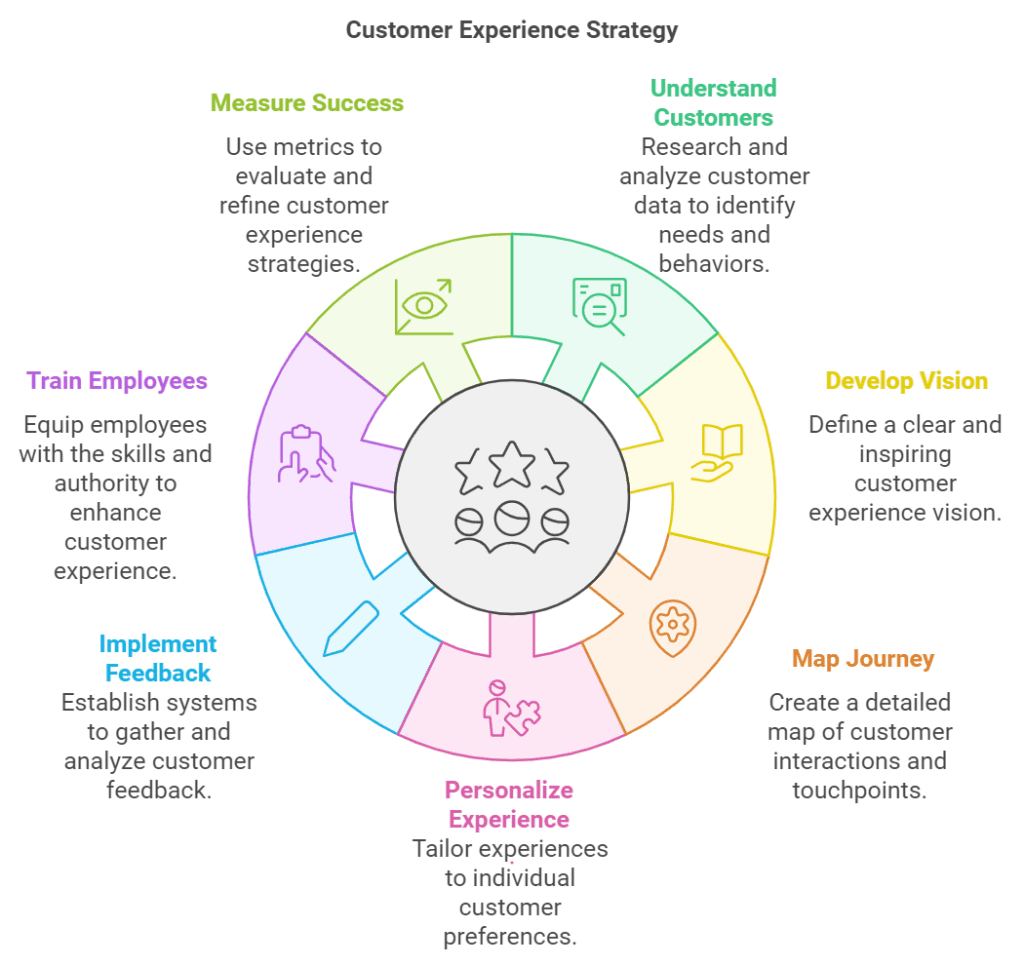How a Customer Experience Strategy Helps Scale Revenue Growth
In today’s competitive market, providing an exceptional customer experience is no longer optional—it’s a necessity. A well-defined customer experience strategy can significantly impact a company’s revenue growth by enhancing customer satisfaction, increasing loyalty, and driving repeat business. This blog explores how focusing on a customer experience strategy helps scale revenue growth, breaks down key components, and provides actionable insights to implement in your business.
What is a Customer Experience Strategy?
A customer experience strategy is a deliberate plan that businesses use to manage and improve the interactions customers have with their brand across various touchpoints. This strategy ensures that every interaction is seamless, satisfying, and builds a long-term relationship with the customer.
Companies that excel in crafting and implementing a strong customer experience strategy often see measurable results, such as increased customer retention, positive word-of-mouth marketing, and, ultimately, a boost in revenue.
Why is a Customer Experience Strategy Important for Revenue Growth?
Businesses today operate in a highly saturated market where customers have numerous options at their fingertips. In such a landscape, offering a superior customer experience strategy sets your brand apart from competitors. Here are the key reasons why an effective customer experience strategy can directly impact revenue growth:
1. Improves Customer Retention
Acquiring new customers can be five times more expensive than retaining existing ones. A well-executed customer experience strategy ensures that your existing customers are satisfied, leading to higher retention rates. Satisfied customers are more likely to make repeat purchases and remain loyal to your brand, contributing to consistent revenue growth.
2. Increases Customer Lifetime Value (CLV)
A superior customer experience boosts Customer Lifetime Value (CLV), which refers to the total revenue a business can expect from a single customer over their lifetime. The better the experience, the longer a customer will stay, and the more money they will spend on your products or services.
3. Drives Word-of-Mouth Marketing
Happy customers are more likely to share their positive experiences with friends and family, leading to organic growth. Word-of-mouth recommendations are highly trusted, and they play a significant role in attracting new customers without added marketing costs.
4. Reduces Customer Churn
Customers who experience unresolved issues or poor service are more likely to leave for a competitor. A robust customer experience strategy focuses on addressing customer pain points and providing quick resolutions, thereby reducing churn and protecting your revenue streams.
Key Components of an Effective Customer Experience Strategy
Crafting a customer experience strategy involves several key components. Here’s a breakdown:
1. Customer Journey Mapping
A comprehensive customer journey map visualizes every stage of the customer’s interaction with your brand. From awareness to post-purchase support, understanding each step allows you to optimize touchpoints to create a seamless and positive experience.
2. Personalization
Customers appreciate businesses that understand their needs. Personalization in a customer experience strategy involves tailoring interactions, offers, and communication based on customer preferences and behavior, making them feel valued and understood.
3. Omnichannel Approach
Customers expect consistent and unified experiences across multiple channels—be it online, in-store, or on social media. An omnichannel strategy ensures that no matter how a customer interacts with your brand, they receive the same high-quality service.
4. Feedback Loop
Feedback is essential for continuous improvement. Implement systems to gather and analyze customer feedback regularly. Whether through surveys, reviews, or social media, understanding customer sentiments enables businesses to make data-driven decisions.
5. Employee Engagement
Employees play a pivotal role in delivering a positive customer experience. Investing in training, support, and motivation helps ensure that employees are equipped to offer exceptional service, which in turn contributes to revenue growth.
Steps to Implement a Successful Customer Experience Strategy

Implementing a well-rounded customer experience strategy involves a systematic approach. Follow these steps to ensure success:
Step 1: Understand Your Customers
Research and understand your target audience. Use data analytics to identify customer pain points, preferences, and behaviors.
Step 2: Develop a Clear Customer Experience Vision
Define what a successful customer experience looks like for your brand. This vision will serve as a guiding principle for your strategy.
Step 3: Map the Customer Journey
Create a customer journey map that identifies all touchpoints across the customer lifecycle. Analyze these interactions to understand where improvements are needed.
Step 4: Personalize the Experience
Leverage customer data to personalize experiences, including targeted marketing campaigns, tailored product recommendations, and personalized customer service.
Step 5: Implement Feedback Systems
Establish mechanisms for gathering customer feedback at various stages of their journey. Regularly analyze this data to identify areas for improvement.
Step 6: Train and Empower Employees
Invest in your employees by providing them with the tools, training, and autonomy needed to resolve customer issues effectively.
Step 7: Measure Success
Use key metrics such as Customer Satisfaction Score (CSAT), Net Promoter Score (NPS), and Customer Retention Rate (CRR) to evaluate the success of your customer experience strategy. Continuously refine your strategy based on these metrics.
Benefits of a Customer Experience Strategy for Revenue Growth
A strong customer experience strategy delivers numerous benefits that contribute to revenue growth:
1. Increased Customer Loyalty
Customers who enjoy consistent positive experiences with your brand are more likely to become loyal. Loyal customers tend to make repeat purchases and advocate for your brand, leading to increased sales and growth.
2. Reduced Marketing Spend
When customers have a great experience, they are more likely to recommend your products or services to others. This organic word-of-mouth marketing reduces the need for extensive marketing efforts and costs, increasing profitability.
3. Premium Pricing
Brands that offer exceptional experiences can often charge premium prices. Customers are willing to pay more for a superior experience, which drives higher revenue margins.
4. Operational Efficiency
A well-designed customer experience strategy also contributes to operational efficiency. By streamlining processes and addressing customer pain points, businesses can reduce costs associated with support, complaints, and returns, which positively impacts revenue.
Table: Key Metrics to Track for Revenue Growth Through Customer Experience
| Metric | Description | Impact on Revenue Growth |
|---|---|---|
| Customer Satisfaction (CSAT) | Measures how satisfied customers are with a product or service. | High satisfaction leads to repeat business and increased loyalty. |
| Net Promoter Score (NPS) | Gauges customer loyalty by asking how likely customers are to recommend your brand. | Higher NPS reflects better word-of-mouth marketing and brand advocacy. |
| Customer Retention Rate (CRR) | The percentage of customers who continue doing business with your brand over time. | Retaining customers boosts lifetime value and reduces acquisition costs. |
| Customer Churn Rate | The percentage of customers who stop using your product or service. | Lower churn means fewer lost customers, directly increasing revenue. |
| Average Order Value (AOV) | The average amount spent each time a customer places an order. | Higher AOV drives increased revenue from each transaction. |
Actionable Tips to Enhance Your Customer Experience Strategy
- Focus on Personalization: Customers expect tailored experiences. Use data to offer personalized recommendations, promotions, and services.
- Respond Quickly: Speed is crucial in today’s fast-paced environment. Quick responses to customer inquiries or complaints build trust and improve satisfaction.
- Invest in Technology: Use CRM systems, chatbots, and AI-powered tools to streamline customer interactions and provide real-time support.
- Monitor Customer Feedback: Regularly review customer feedback to stay aligned with their needs and expectations.
Conclusion
A robust customer experience strategy is vital for scaling revenue growth. By prioritizing customer satisfaction, businesses can increase customer retention, drive loyalty, and reduce churn. Implementing personalized, seamless, and proactive experiences will lead to higher lifetime value and organic growth.
Investing in a well-thought-out customer experience strategy not only helps retain customers but also creates advocates who drive new business, contributing to long-term revenue success.

